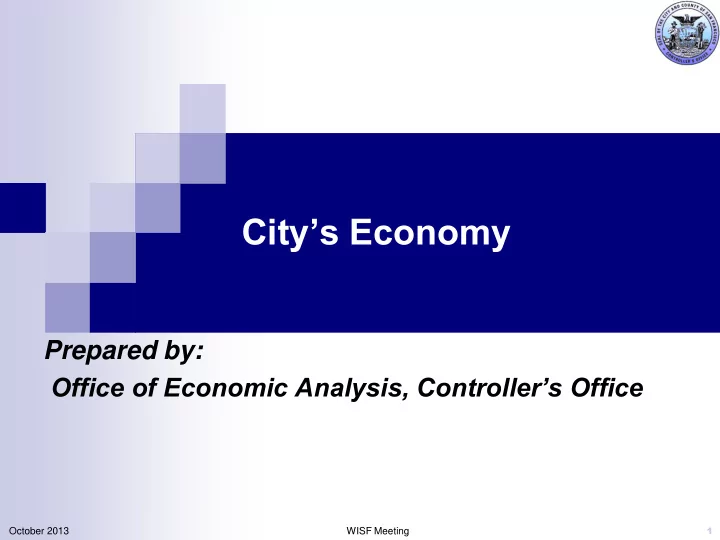

City’s Economy Prepared by: Office of Economic Analysis, Controller’s Office 1 October 2013 WISF Meeting
The Unemployment Rate Has Been Falling Because We Have Been Adding Jobs San Francisco Labor Force vs. Unemployment Rate: 2007-2012 Labor Force Unemployment Rate 490,000 12% 480,000 10% 470,000 8% Unemployment Rate 460,000 Labor Force 450,000 6% 440,000 4% 430,000 2% 420,000 410,000 0% 2007 2008 2009 2010 2011 2012 2 Source: CA Employment Development Department
Private Sector Employment has Recovered to Pre-Recession Levels San Francisco Private Sector Employment: 2007-2012 500,000 490,000 480,000 470,000 460,000 450,000 440,000 430,000 420,000 2007 2008 2009 2010 2011 2012 3 Source: Bureau of Labor Statistics
San Francisco is the Fastest Growing Large County in the United States Annual Private Sector Employment Growth Rate, 2011-12: Ten Fastest Growing U.S. Counties with > 250,000 Employees 7.0% 6.1% 6.0% 5.3% 5.2% 5.1% 5.0% 4.8% 4.5% 4.5% 4.4% 4.3% 4.2% 4.0% 3.0% 2.0% 1.0% 0.0% San Francisco Austin Suburban Suburban San Mateo Houston Santa Clara Alameda Suburban Nashville Dallas Grand Rapids Detroit 4 Source: Bureau of Labor Statistics
Every Sector in the City's Economy is Outpacing the US Growth Rate Employment Growth Rate, 2011-12: San Francisco Sectors and the U.S. Average Information 12.1% Professional and business services 8.8% Other services 8.7% Construction 8.4% Manufacturing 5.3% Leisure and hospitality 5.0% Trade, transportation, and utilities 4.0% Education and health services 3.7% Financial activities 2.6% United States all industries 1.9% 0.0% 2.0% 4.0% 6.0% 8.0% 10.0% 12.0% 14.0% 5 Source: Bureau of Labor Statistics
Over 25% of Jobs Added Last Year Came from the Tech Sector Jobs Added, 2011-12: Tech Sector vs. All Other Sectors Tech Sector 7,701 All Other Sectors 28,722 Source: Bureau of Labor Statistics Note: Tech Sector is defined as three major IT Service Industries which include Computer Systems Design 6 (NAICS 5415), Internet Publishing (NAICS 51913), Software Publishing (NAICS 5112)
San Francisco Added Nearly Twice as Many Tech Jobs as Santa Clara County Absolute Employment Change, Three Major IT Service Industries: San Francisco, San Mateo, and Santa Clara Counties, 2011-12 9,000 8,000 Computer Systems Design (NAICS 5415) Internet Publishing (NAICS 51913) 7,000 Software Publishing (NAICS 5112) 6,000 5,000 4,000 3,000 2,000 1,000 0 San Francisco San Mateo County Santa Clara County 7 Source: Bureau of Labor Statistics
SF Housing is the Highest Priced, and also among the Fastest-Appreciating Median Housing Value and Housing Appreciation, 2011-12: San Francisco and Fifteen Other U.S. Cities $900,000 San Francisco $800,000 $700,000 San Jose $600,000 Honolulu Median Home Value $500,000 San Diego New York Washington Los Angeles $400,000 Seattle Boston Oakland $300,000 Portland Austin Chicago $200,000 Houston Philadelphia Atlanta $100,000 $0 0% 5% 10% 15% 20% 25% 30% Housing Appreciation, 2011-12 8 Source: Zillow
Rent Control Somewhat Moderates the Impact of Rising Values on the Economy Annual Growth in Asking Rents, Allowable Rent Increases Under Rent Control, and Median Rent Paid by all Tenants, 2011-12 12.9% 7.2% 1.9% Average Asking Rent Allowable Rent Increase under Rent Control Median Rent Paid 9 Source: RealFacts, SF Rent Board, U.S. Census Bureau
Wages Growing More Slowly Than Rent for Most Sectors of the Economy Percentage Change in Average Annual Earnings in San Francisco by Sector, 2011-12 20.0% 15.0% 10.0% 5.0% 0.0% -5.0% 10 Source: Bureau of Labor Statistics
Stock Prices Don’t Suggest a Tech Bubble At This Point NASDAQ Composite Index: Historical Valuation Source: Bloomberg 600 6,000 550 5,500 500 5,000 NASDAQ Composite Index (Price) 450 4,500 400 4,000 P/E Ratio (ttm) 350 3,500 300 3,000 250 2,500 200 2,000 150 1,500 100 1,000 50 500 0 0 Jan-95 Aug-95 Mar-96 Oct-96 May-97 Dec-97 Jul-98 Feb-99 Sep-99 Apr-00 Nov-00 Jun-01 Jan-02 Aug-02 Mar-03 Oct-03 May-04 Dec-04 Jul-05 Feb-06 Sep-06 Apr-07 Nov-07 Jun-08 Jan-09 Aug-09 Mar-10 Oct-10 May-11 Dec-11 Jul-12 Feb-13 Sep-13 P/E Ratio NASDAQ Composite Index (Price) 11
However There Are Reasons for Concern In the Local Economy Some area tech companies have price-earnings ratios that are reminiscent of the dot-com bubble. If this becomes a broader trend in technology, this would be clearer sign of a bubble. Technology has historically been a highly cyclical industry; the greater the run-up, the more dramatic the decline. 12
Conclusion The City recovered the jobs it lost during the recession The recovery has been largely driven by employment in the Technology Sector Demand for housing has driven up housing and rental prices. Wages in most sectors have not kept up with housing costs No sign of a technology bubble yet in the broad NASDAQ. However, there are reasons for concern in the local Tech Sector. 13
Recommend
More recommend